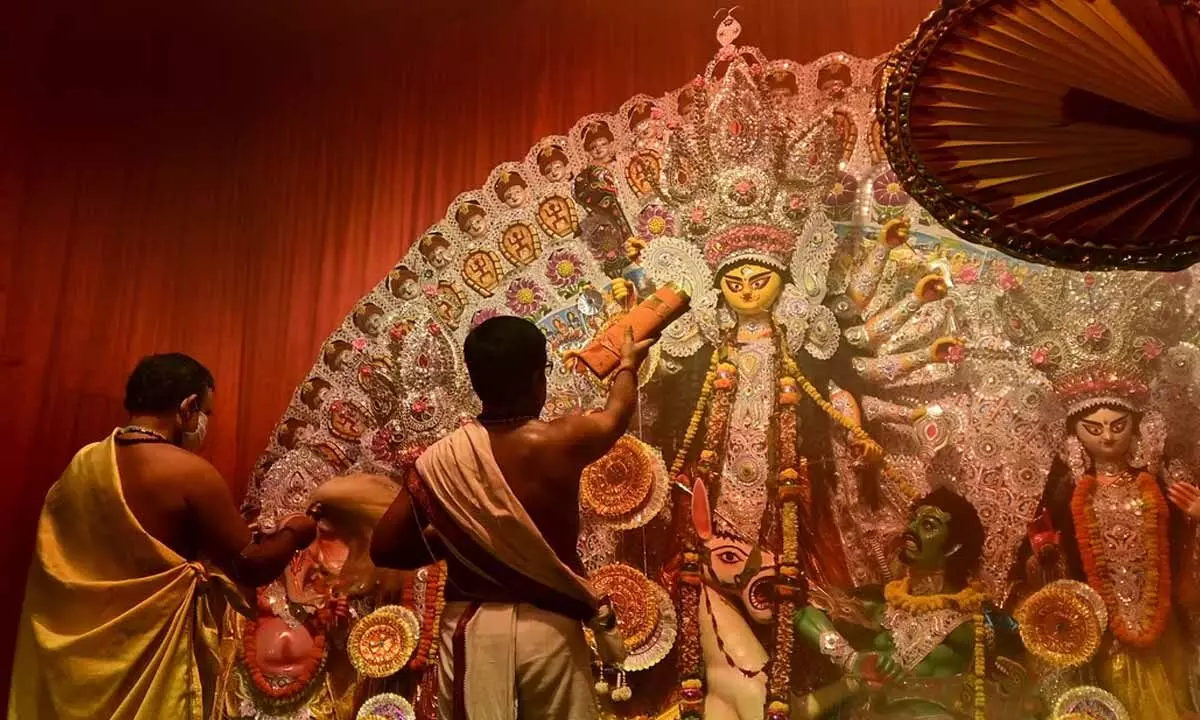Live
- India Faces Blow as Pacer Mohammed Shami Ruled Out for Remainder of Australia Series
- Biden Pardon: Joe Biden Commutes Death Sentences of 37 Inmates, Including Child Killers and Mass Murderers
- South Korea: Yoon believes impeachment trial takes priority over martial law probe
- Strict Action for Non-Adherence to Time Management - DMHO Dr. Swarajya Lakshmi
- Over 13.29 lakh houses approved for rural poor in Maharashtra: Shivraj Chouhan
- District Collector Urges Timely Completion of Indiramma Housing Scheme Survey
- Digital Arrest Scam: Hyderabad Man Duped of ₹7 Lakhs by Fake Crime Branch Police Callers
- Sukhbir Badal seeks President's Police medal for officer who saved his life
- US Firm Accordion Acquires Merilytics, Launches 1,500-Seater Office in Hyderabad
- Free Medical Camp Organized by Alampur Advocate Bar Association
Just In
When is Dussehra 2023? Appointments, Shubh Muhurats, rituals and celebrations across India


Dussehra is celebrated on the tenth day of the Hindu lunar month of Ashwin. It is a special day that signifies the victory of good over evil.
Dussehra is celebrated on the tenth day of the Hindu lunar month of Ashwin. It is a special day that signifies the victory of good over evil. Additionally, Dussehra marks the conclusion of Navratri, a nine-night festival where people worship various forms of the goddess Durga. This year, Dussehra or Vijayadashmi will be celebrated on October 24, 2023 (Tuesday).
Dussehra is also known by different names in various parts of India, reflecting the rich cultural diversity of India. It is called Durga Puja or Vijayadashami in the east and northeast, while in the northern and western states it is known as Dussehra.
Dussehra 2023: history and meaning
Rama's victory over Ravana signifies the eternal triumph of good over evil and serves as a powerful reminder that good prevails, regardless of the difficulties it faces. Dussehra is a time to commemorate this profound lesson and reaffirm our commitment to combat evil in all its manifestations.
Dussehra 2023: Shubh Muhurat
These are the schedules and important details:
1. Vijay Muhurat Time: 1:58 p.m. to 2:43 p.m.
2. Aparahna Puja Time: 01:13 p.m. at 03:28 p.m.
3. Dashami Tithi (10th day) Starts: 05:44 p.m. on October 23, 2023 Ends: 03:14 p.m. m. October 24, 2023
4. Shravana Nakshatra starts at 06:44 p.m. on October 22, 2023, and ends at 05:14 p.m. October 23, 2023
Rituals performed on Vijayadashami
1. Shami Puja
The worship of the Shami tree symbolizes the victory of the Pandavas in the Mahabharata.
2. Aparajita Puja
Devotion to Goddess Aparajita means the undefeated spirit of good.
3. Seema Avalanghan
Crossing the border, a practice that embodies the idea of expanding horizons and overcoming limitations.
4. Shastra Puja or Ayudha Puja
On Vijayadashami, Goddess Durga defeated a formidable demon. After her victory, the gods worshipped her weapons. Today, people worship their weapons and tools, offering them to the goddess as a gesture of respect and gratitude.
Dussehra celebrations across India
Below are some regional highlights of Dussehra celebrations in different parts of the country:
1. North India
In the northern region (Delhi, Haryana, Uttar Pradesh and the Kullu Valley), the festival is characterized by vibrant Ramlila performances, where the epic story of Lord Rama is unfolded through dramatic performances. In these states, the burning of Ravana's effigy symbolizes the victory of righteousness.
2. Eastern India
In the eastern states of West Bengal, Jharkhand and Bihar, Dussehra is celebrated with distinct fervour and traditions. The Durga Puja in West Bengal is a big event.
3. South India
Mysore in Karnataka and various parts of Tamil Nadu celebrate Dussehra with great zeal. Mysore is famous for its majestic procession in which the idol of goddess Chamundeshwari appears atop a lavishly decorated elephant. In Tamil Nadu, the festival is marked by colorful and energetic folk dances.
4. Western India
In Gujarat and Maharashtra, Dussehra coincides with the exuberant Navratri festival. The entire state erupts in vibrant dance and music, with people taking part in traditional Garba and Dandiya Raas dances.
Ramlila during Dussehra
Ramlila is an important part of Dussehra celebrations. It is a traditional folk theatre performance depicting the life and story of Lord Rama, as told in the Hindu epic Ramayana. Ramlila is usually performed over a period of several days or weeks before Dussehra.
The performances occur in theatres or open-air stages and are attended by many people. The actors are usually residents, and the costumes and sets are often elaborate. Ramlila performances are usually accompanied by music and singing.
The Ramayana tells the story of Lord Rama's victory over the demon king Ravana. Rama is the seventh avatar of the Hindu god Vishnu, and Ravana is the symbol of evil. Ramlila's performances highlight the importance of good over evil and teach audiences the values of dharma (righteousness) and karma (the law of cause and effect).
On Dussehra day, Ramlila performances culminate with the burning of effigies of Ravana, Kumbhakarna (Ravana's brother) and Meghnada (Ravana's son). This symbolizes the victory of good over evil.
Ramlila is a famous and important part of Dussehra celebrations because it allows people to connect with their culture and religion. It is also a way for people to learn about the values of dharma and karma.

© 2024 Hyderabad Media House Limited/The Hans India. All rights reserved. Powered by hocalwire.com






